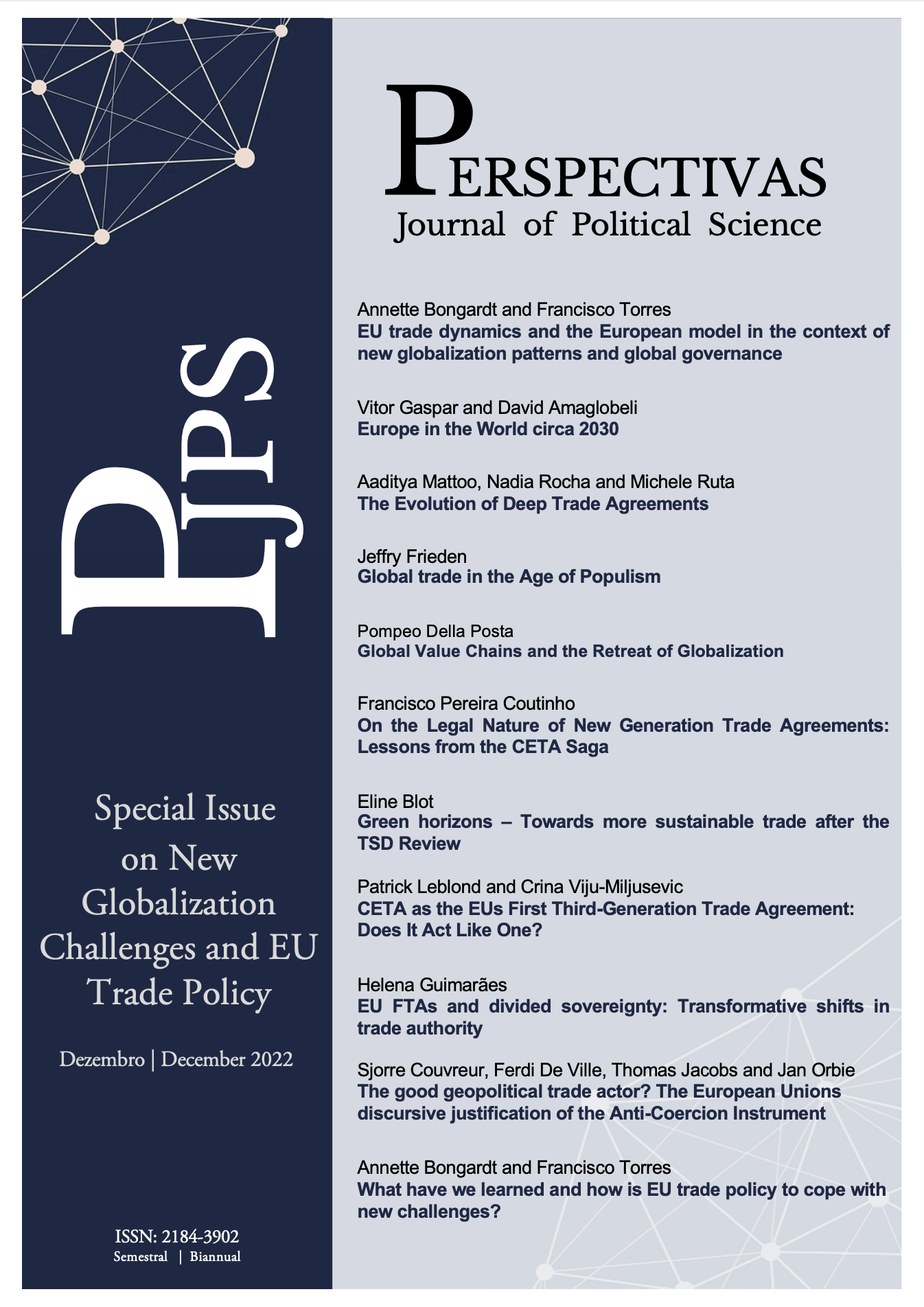Article 8 - CETA as the EU's First Third-Generation Trade Agreement: Does It Act Like One?
DOI:
https://doi.org/10.21814/perspectivas.4496Palavras-chave:
Third generation trade agreements, CETA, regulatory cooperation, procurement, movement of peopleResumo
The Comprehensive Economic and Trade Agreement (CETA) between Canada and the European Union (EU) has been hailed as the trend-setter for third-generation trade agreements, which focus predominantly on beyond-the-border impediments to international trade (e.g., rules and regulations) than at-the-border barriers (e.g., tariffs). CETA formed the basis for subsequent EU trade agreements, which are a key element of the EU’s trade policy. It also provided inspiration for third-generation trade agreements outside the EU. The big question for trade policy, in the EU and beyond, is whether third-generation trade agreements achieve their intended objectives with respect to beyond-the-border obstacles to trade. In other words, are they effective instruments in liberalizing international trade? After all, facilitating trade through regulatory and administrative cooperation is much more difficult than eliminating or lowering tariffs on imported goods. Having been in force (provisionally) for five years, CETA offers the best case to study the effectiveness of third-generation trade agreements.
Downloads
Referências
Allee, T., Elsig, M. and Lugg, A. (2017). “Is the European Union Trade Deal with Canada New or Recycled? A Text-as-data Approach”. Global Policy 8(2): 246-252. DOI: https://doi.org/10.1111/1758-5899.12420
Brender, N. (2014). “Across the Sea with CETA: What New Labour Mobility Might Mean for Canadian Business.” Briefing, July. Ottawa, ON: The Conference Board of Canada.
Caballero, E.S. (2022). “The modernization of the European Union-Mexico Association Agreement: between change and continuity.” EU-LAC Foundation, Occasional paper FC/EU-LAC (7). Available at https://eulacfoundation.org/sites/default/files/2022-06/Especial_FC_EULAC_7_EN.pdf.
Camilleri, M. (2022). “Regulatory Cooperation under CETA: Facing Up to the “Gorilla in the Room”.” In R.G. Finbow (ed.) CETA Implementation and Implications: Unravelling the Puzzle. Montreal: McGill-Queen’s University Press (pp. 97-115).
Casier, L. (2019). “Canada’s International Trade Obligations: Barrier or Opportunity for Sustainable Public Procurement? Unpacking Canada's WTO GPA and CETA Commitments in Relation to Sustainable Procurement.” IISD Report, International Institute for Sustainable Development. https://www.iisd.org/sites/default/files/publications/canada-international-trade-spp.pdf.
Couvreur, A. (2015). “New Generation Regional Trade Agreements and the Precautionary Principle: Focus on the Comprehensive Economic and Trade Agreement (CETA) between Canada and the European Union.” Asper Review of International Business and Trade Law 15: 265-292.
Deblock, C. (2022). “Canada and International Regulatory Cooperation: A Comparison of USMCA, CETA and CPTPP.” In G. Gagné and M. Rioux (eds.) NAFTA 2.0. From the First NAFTA to the United States-Mexico-Canada Agreement. Palgrave MacMillan. DOI: https://doi.org/10.1007/978-3-030-81694-0_12
Dendrinou, V. and Verlaine, J.-A. (2016). “EU, Canada Sign Landmark Free-Trade Agreement”, The Wall Street Journal, October 30. https://www.wsj.com/articles/eu-canada-prepare-to-sign-ceta-trade-deal-1477831000.
D’Erman, V.J. (2020). “The EU’s Realist Power: Public Procurement and CETA Negotiations with Canada.” Journal of International Relations and Development 23(1): 1–23. DOI: https://doi.org/10.1057/s41268-018-0135-3
Doutriaux, Y. (2015). “La reconnaissance des qualifications professionnelles: Entente France-Québec et AECG.” In C. Deblock, J. Lebullenger and S. Paquin (eds.) Un nouveau pont sur l’Atlantique: L’Accord économique et commercial global entre l’Union européenne et le Canada. Quebec, QC: Presses de l’Université du Québec (pp. 249-259).
European Commission. (2017a). Report from the Commission to the European Parliament, the Council, the European Economic and Social Committee and the Committee of the Regions on implementation of free trade agreements 1 January 2016-31 December 2016, Directorate-General for Trade. Publications Office, https://data.europa.eu/doi/10.2781/085887.
European Commission. (2017b). Ex-post evaluation of the implementation of the EU- Mexico Free Trade Agreement, Directorate-General for Trade. https://trade.ec.europa.eu/doclib/docs/2017/august/tradoc_156011.pdf.
European Commission (2018). Report from the Commission to the European Parliament, the Council, the European Economic and Social Committee and the Committee of the Regions on implementation of free trade agreements 1 January 2017 - 31 December 2017, Directorate-General for Trade. Publications Office, https://trade.ec.europa.eu/doclib/docs/2018/october/tradoc_157468.pdf.
European Commission (2022a). Switzerland. Directorate-General for Trade. https://trade.ec.europa.eu/access-to-markets/en/content/switzerland.
European Commission (2022b). EU-Colombia-Peru-Ecuador Trade Agreement. Directorate- General for Trade. https://trade.ec.europa.eu/access-to-markets/cs/content/eu-colombia-peru-ecuador-trade-agreement.
European Commission (2022c). EU and Canada lay the foundations for free movement of architects. 21 March. https://policy.trade.ec.europa.eu/news/eu-and-canada-lay-foundations-free-movement-architects-2022-03-21_en.
Fahey, E. (2017). “CETA and Global Governance Law: What Kind of Model Agreement Is It Really in Law?”. European Papers 2(1): 293-302. https://www.europeanpapers.eu/en/system/files/pdf_version/EP_EF_2017_I_007_Elaine_Fahey_00119.pdf.
Gaisford, J.D. and Kerr, W. A. (2001). Economic Analysis for International Trade Negotiations. Cheltenham: Edward Elgar Press.
Gaisford, J.D., Kerr, W.A. and Perdikis, N. (2003). Economic Analysis for EU Accession Negotiations – Agri-Food Issues in the EU’s Eastward Expansion. Cheltenham: Edward Elgar Press.
Gantz, D.A. (2004). “The Evolution of FTA Investment Provisions: From NAFTA to the United States Chile Free Trade Agreement.” American University International Law Review 19(4): 679-768.
Gantz, D.A. (2022). “Canada’s Approaches to Investor-State Dispute Settlement: Addressing Divergencies among CETA, USMCA, CPTPP, and the Canada-China FIPA.” In R.G. Finbow (ed.) CETA Implementation and Implications: Unravelling the Puzzle. Montreal: McGill-Queen’s University Press (pp. 183-209).
Global Affairs Canada (2018). 1st Meeting of the CETA Regulatory Cooperation Forum. https://www.international.gc.ca/trade-commerce/trade-agreements-accords-commerciaux/agr-acc/ceta-aecg/2018-12-14_rcf_report-rapport_fcr.aspx?lang=eng.
Global Affairs Canada (2020). 2nd Meeting of the CETA Regulatory Cooperation Forum. https://www.international.gc.ca/trade-commerce/trade-agreements-accords-commerciaux/agr-acc/ceta-aecg/2020-02-RCF_report-FCMR_rapport.aspx?lang=eng.
Global Affairs Canada and European Commission. (2021). “An Overview of Canada-EU Trade Performance under CETA.“ Second Canada-EU CETA Joint Committee Meeting. https://www.international.gc.ca/trade-commerce/assets/pdfs/economist-economiste/statistics-statistiques/joint-ceta-statistics-report-ec_final-np-en.pdf.
Global Affairs Canada. (2021). 2021 Canada’s State of Trade. A Closer Look at Foreign Direct Investment. Office of the Chief Economist. https://www.international.gc.ca/transparency-transparence/assets/pdfs/state-trade-commerce-international/SoT-ENG.pdf.
Global Affairs Canada. (2022a). CETA@5 Delivering trade benefits during unprecedented times. Office of the Chief Economist. https://www.international.gc.ca/trade-commerce/economist-economiste/analysis-analyse/benefits-ceta5-avantages.aspx?lang=eng.
Global Affairs Canada, (2022b). 2022 Canada’s State of Trade. The Benefits of Free Trade Agreements. Office of the Chief Economist. https://www.international.gc.ca/transparency-transparence/assets/pdfs/state-trade-commerce-international/2022/sot-2022-eng.pdf.
Global Affairs Canada. (2022c). Comprehensive Economic and Trade Agreement Regulatory Cooperation Forum - Work Plan. https://www.international.gc.ca/trade-commerce/trade-agreements-accords-commerciaux/agr-acc/ceta-aecg/2021-07-28-work-travail-plan.aspx?lang=eng.
Global Affairs Canada. (2022d). 4th Meeting of the CETA Regulatory Cooperation Forum. https://www.international.gc.ca/trade-commerce/trade-agreements-accords-commerciaux/agr-acc/ceta-aecg/2022-05-03-rcf_summary-sommaire_fcr.aspx?lang=eng.
Goff, P. (2014). “Transatlantic Economic Agreements: Parsing CETA and TTIP”. CIGI Papers No. 35, Centre for International Governance Innovation, July 21. https://www.cigionline.org/static/documents/cigi_paper_35_0.pdf.
Golberg, E. (2019). Regulatory Cooperation – A Reality Check. M-RCBG Working Paper No. 115. Available at https://www.hks.harvard.edu/sites/default/files/centers/mrcbg/img/115_final.pdf
González, M., Gordo, E. and Manrique, M. (2017). “The EU’s new-generation trade agreements: the CETA treaty.” Economic Bulletin, Banco de España, issue SEP: 1-7.
Grier, J.H. (2020). “Growing Significance of Regional Trade Agreements in Opening Public Procurement.” In A. Castelli, G. Piga, S. Saussier and T. Tátrai (eds) The Challenges of Public Procurement Reforms. New York: Routledge (pp. 184-218). DOI: https://doi.org/10.4324/9781003023470-15
Harbine, J. (2002). “NAFTA Chapter 11 Arbitration: Deciding the Price of Free Trade.” Ecology Law Quarterly 29(2): 371–394.
Hobbs, J.E. (2007). “Technical Barriers to Trade.” In W.A. Kerr and J.D. Gaisford (eds.) Handbook on International Trade Policy. Cheltenham: Edward Elgar Press (pp. 394-403).
Hoekman, B. and Sabel, C. (2019). “Open Plurilateral Agreements, International Regulatory Cooperation and the WTO.” Global Policy 10(3): 297-312. DOI: https://doi.org/10.1111/1758-5899.12694
James, S. and Anderson, K. (2005). “On the Need for More Economic Assessment of Quarantine Policies.” In K. Andersonn and T. Josling (eds.) In the WTO and Agriculture, Vol. II. Cheltenham: Edward Elgar Press (pp. 197-216).
Katunar, M., Maljak, M. and Martinić, S. (2014). “The Evolution of the EU’s Foreign Trade Policy.” Available at https://hrcak.srce.hr/file/216772
Kerr, W.A. (2006). “International Harmonization and the Gains from Trade.” Journal of International Law and Trade Policy 7(2): 116-125.
Leblond, P. (2016). “Making the Most of CETA: A Complete and Effective Implementation Is Key to Realizing the Agreement's Full Potential.” CIGI Papers No. 114, Centre for International Governance Innovation, October 30, https://www.cigionline.org/publications/making-most-ceta-complete-and-effective-implementation-key-realizing-agreements-full-0/.
Leblond, P. and Viju-Miljusevic, C. (2019). “EU trade policy in the twenty-first century: change, continuity and challenges.” Journal of European Public Policy 26(12): 1836–1846. DOI: https://doi.org/10.1080/13501763.2019.1678059
Lester, S., Manak, I. and Ikenson, D. (2017). “Renegotiating NAFTA in the Era of Trump: Keeping the Trade Liberalization In and the Protectionism Out.” CATO Working Paper 46. Available at https://assets.realclear.com/files/2017/08/648_nafta.pdf.
Madner, V. (2017). “A New Generation of Trade Agreements: An Opportunity Not to Be Missed?” In S. Griller, W. Obwexer and E. Vranes (eds) Mega-Regional Trade Agreements: CETA, TTIP, And TiSA: New Orientation for EU External Economic Relations, Oxford: Oxford Academic, pp. 308-315.
Mattoo, A., Rocha, M. and Ruta, M. (2020). “The Evolution of Deep Trade Agreements.” In Mattoo, A., Rocha, M. and Ruta, M. (eds). Handbook of Deep Trade Agreements. Washington, DC: The World Bank. DOI: https://doi.org/10.1596/1813-9450-9283
Mignon, N. (2020). “The CETA Report on Mobility of Professionals.” EU Delegation to Canada. https://trade.ec.europa.eu/doclib/docs/2020/december/tradoc_159158.pdf.
Neuwahl, N.A.E.M. (2021). “The 2020 EU-UK Trade and Cooperation Agreement as a Canada Style Agreement”. May 19, EU3D Research Paper No. 4, https://ssrn.com/abstract=3633959. DOI: https://doi.org/10.2139/ssrn.3633959
OECD (1994). Regulatory Cooperation for an Independent World. Paris: OECD Publishing. Available at https://www.oecd-ilibrary.org/governance/regulatory-co-operation-for-an-interdependent-world_9789264062436-en. DOI: https://doi.org/10.1787/9789264062436-en
Rioux, M., Ares, M. and Huang, P. (2015). “Beyond NAFTA with Three Countries: The Impact of Global Value Chains on an Outdated Trade Agreement.” Open Journal of Political Science 5: 264-276. DOI: https://doi.org/10.4236/ojps.2015.54028
Rioux, M., Deblock, C. and Wells, G.-P. (2020). “CETA, an Innovative Agreement with Many Unsettled Trajectories.” Open Journal of Political Science 10: 50-60. DOI: https://doi.org/10.4236/ojps.2020.101005
Rodrik, D. (2018). “What Do Trade Agreements Really Do?” Journal of Economic Perspectives 32(2): 73-90. DOI: https://doi.org/10.1257/jep.32.2.73
Ruffat, A. and Leblond, P. (2022). “Public Procurement under CETA Chapter 19.” In R.G. Finbow (ed.) CETA Implementation and Implications: Unravelling the Puzzle. Montreal: McGill-Queen’s University Press (pp. 143-158).
Śliwińska, M. (2019). “New generation trade agreements as an economic challenge for the European Union and its Member States – the case of CETA.” Przegla̦d Europejski 4(4): 141–158. DOI: https://doi.org/10.5604/01.3001.0013.3485
Statistics Canada (2022). “International investment position, Canadian direct investment abroad and foreign direct investment in Canada, by industry and select countries, annual (x1,000,000)”, Table 36-10-0659-01, https://www150.statcan.gc.ca/t1/tbl1/en/tv.action?pid=3610065901.
Van Rooy, C. (2022). “A Cautionary Tale of Regulatory Cooperation in CETA: Executive Expertise and the Influence of Foreign Governments in Domestic Regulatory Processes.” In R.G. Finbow (ed.) CETA Implementation and Implications: Unravelling the Puzzle. Montreal: McGill-Queen’s University Press (pp. 116-140).
WTO (2015). “Trade in Services: The Most Dynamic Segment of International Trade.” Geneva: World Trade Organization. Available at https://www.wto.org/english/thewto_e/20y_e/services_brochure2015_e.pdf.
Yeung, M.T., Perdikis, N. and Kerr, W.A. (1999). Regional Trading Blocs in the Global Economy: The EU and ASEAN. Cheltenham: Edward Elgar Press.
Downloads
Publicado
Como Citar
Edição
Secção
Licença
Direitos de Autor (c) 2022 Perspectivas - Journal of Political Science

Este trabalho encontra-se publicado com a Creative Commons Atribuição-NãoComercial 4.0.
Authors must be sure that they have permission to reproduce copyright material, prior to submitting their articles to this Journal.
Authors must secure permission if they have permission to reproduce figures, tables, or any extract from the text of another source. This applies to direct reproduction as well as to any derivative reproduction.
In assigning copyright, authors retain their right to use their own material elsewhere, provided that the Journal is acknowledged as the original place of publication, and the Editorial Team is notified in writing in advance.
Further information on copyright policy please contact info@perspectivasjournal.com








